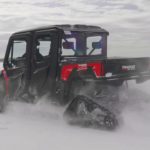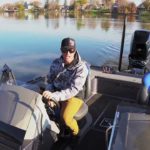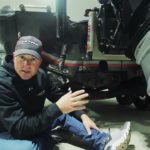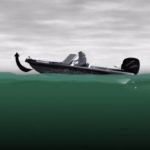The Beast
This article was originally printed in the 2014 Nitro Performance Fishing Boats magazine and is reprinted here courtesy of Tracker Marine Group.
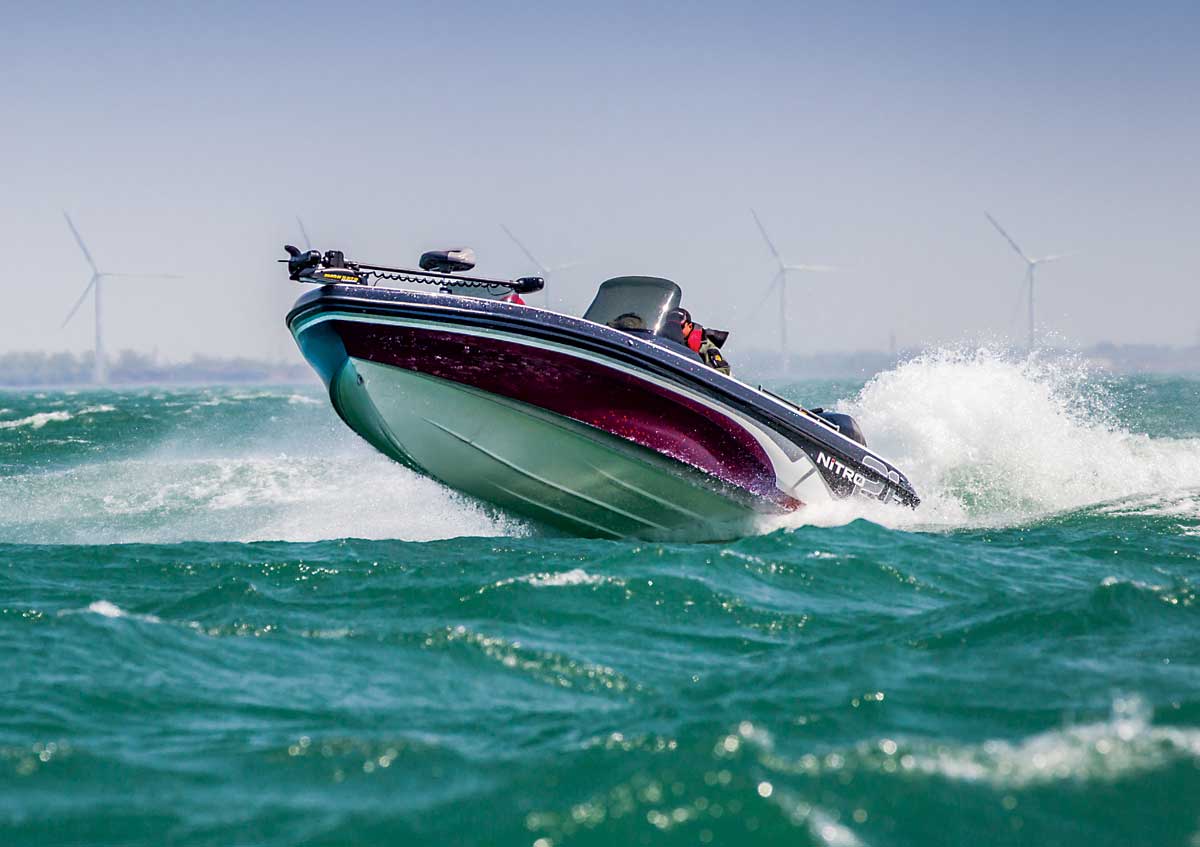 Numbing winds blow across an expanse of water so big the other shore is just a blur in the distance. Waves tipped with threatening white caps roll past. Clouds hang menacingly on the horizon.
Numbing winds blow across an expanse of water so big the other shore is just a blur in the distance. Waves tipped with threatening white caps roll past. Clouds hang menacingly on the horizon.
Walleye heaven truly can be in a really hard place to reach.
And to access those great fisheries, or even just to traverse them on the way back from a day of fishing, Northern anglers need a special kind of boat. One tough enough to take a beating and continue onward, yet still able to provide the performance needed to slice through the waves and take the conditions.
Safely. Soundly.
Time and time again.
Welcome to the ZV 21.
In the beginning
As is the situation with all new NITRO boats, the team saw an opportunity to bring NITRO quality, performance and value to a new group of anglers.
In this case, the intended audience were Northern anglers who regularly brave the notoriously rough conditions of the Great Lakes, as well as other bodies where the walleye and muskie fishing is just amazing.
It was a three-year process that began with some serious information gathering.
Lance Williams, Senior Product Engineer for NITRO Boats, says the team started by developing a hull that would fit the needs of those who will be using it.
For the ZV 21, it needed to be a Deep V design that was big enough to accommodate the features and larger waters, as well as be longer than the competition. But it still needed to be able to fit in bigger garages or sheds. Hence why they settled in on the 21′ 7″ length and 100″ beam.
“Interior depth was another big thing,” Williams continues. “Fuel capacity and storage arrangement, too. Those were all kind of the basic things we started with.”
Once the engineering team had a hull designed and built, they turned their attention to the deck.
And it was at this point NITRO brought in the Northern anglers.
“Essentially, us on the Northern-based pro staff were extremely involved with the design of the boat,” Gary Parsons explains. “To the point where the measurements were made to the half-inch, as were joint decisions with Lance [Williams] and Tommy Morphis [Director of New Product Development for Tracker Marine Group]. It was a wonderful project to be involved with.”
Steve Mason, Freshwater Product Development Manager, says this was key to ensuring the new boat was designed just right.
“You want to design the boat around what their needs are,” he explains. “They needed a boat that would run as fast, or faster, than some of the aluminum boats would, a boat that would ride more comfortably than an aluminum boat would and featured as that tournament guy would expect it to be featured.”
And by all counts, they succeeded.
Four Northern anglers helped in the design of the boat—Gary Parsons, Keith Kavajecz, Chase Parsons and Jim Carroll. And all four heap loads of praise upon the boat. And for plenty of reasons.
Tough for the rough
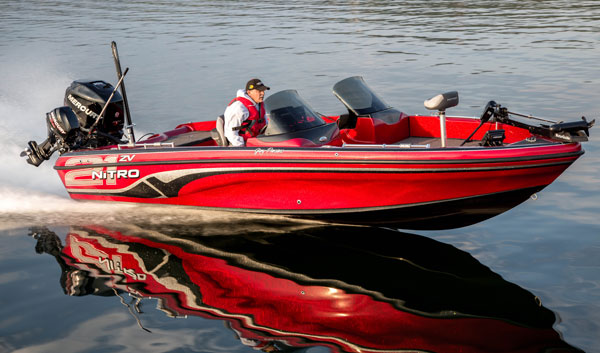 Like all NITRO performance boats, the hull is carefully crafted by skilled workers in a state-of-the-art fiberglass boat plant. It is meticulously hand-laid to ensure proper thickness and the right amount of support in key areas. And every step of the process is thoroughly checked for quality.
Like all NITRO performance boats, the hull is carefully crafted by skilled workers in a state-of-the-art fiberglass boat plant. It is meticulously hand-laid to ensure proper thickness and the right amount of support in key areas. And every step of the process is thoroughly checked for quality.
But, as NITRO requires the ZV 21 to perform a certain way in different conditions than other performance fishing boats, it has a few built-in features that make it perfect for tackling rougher conditions.
To ensure this boat could take a heavy beating, the engineering team concentrated on building a better transom. As with all NITRO models, the transom of the ZV 21 is full-beam and all composite. But to strengthen it even more, the team really worked to structurally support it with the liner system. They also designed the transom to accommodate a huge outboard, as well as a Kicker motor.
Another extra touch of ruggedness is found in the hull sides, where NITRO cores them with balsa core. That gives the boat extremely lightweight, but really stiff, hull sides.
“This boat rides really well over the waves,” Williams explains. “But when they impact one of those large four- to six-footers, one of the biggest structural problems is that if the hull sides aren’t stiff, it gives you that vibration. You hit a wave, and the whole boat will shake and quiver.
“That’s what causes a lot of cracks and structural issues.”
Stiffening the hull sides removes that shock and vibration, ensuring a better ride and maximizing longevity.
The coring makes for a harder-to-manufacture boat, but that’s a trade-off NITRO is willing to make.
“It’s a lot more labor intensive, but so critical to the structural support of that boat,” Williams says.
Another change from the norm was the decision to craft the boat without a splashwell. Williams says that while most of the competition boats have one, it’s easy to get cosmetic cracking in the corner because of the way the boats twist and turn. Instead, NITRO opted to go with a jack plate and non-splashwell.
For Carroll, these performance aspects are huge for pro anglers.
“It gives us a real advantage in the fact that we can run through big waves faster and harder than our competitors can,” he explains.
Just what the anglers ordered
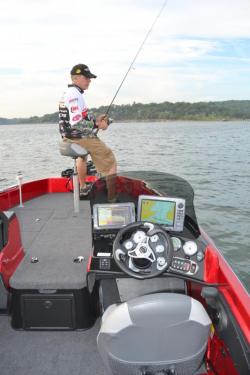 “When we started designing the boat, we gave a long wish list to the engineers of different features, storage things, different ways that we fish and things that would help us fishing, hoping they would do 50, maybe 60 percent of it,” Kavajecz says. “And they ended up doing everything…“We never really heard ‘We can’t do that’ from the designers.”
“When we started designing the boat, we gave a long wish list to the engineers of different features, storage things, different ways that we fish and things that would help us fishing, hoping they would do 50, maybe 60 percent of it,” Kavajecz says. “And they ended up doing everything…“We never really heard ‘We can’t do that’ from the designers.”
Williams described trying to fit the proper features into the boat as a balancing act, because not all anglers will want all the features. Plus, walleye anglers use a variety of techniques in pursuit of their quarry, including trolling with planing boards, long-lining or even sitting still with jig rods.
“It’s such a versatile boat to do what they [professional anglers] need it to do, and at the same time, it can be used by the average angler,” Williams says.
For example, Williams says it was critical to the anglers that the boat hold an insane number of tackle boxes. So, the engineers designed in storage compartments to accommodate. Williams estimates that you can put 22 in one side compartment alone, and more in the others.
“It’s really a small Bass Pro Shops inside,” Williams laughs.
Another unique challenge was that the team wanted a five-battery system—two for the outboard and main electrical accessories and three for trolling. A challenge because batteries easily weigh 65 pounds a piece and are rather large, taking up a lot of space. But one more feature the engineers worked in.
The anglers wanted two large graphs—one to display their GPS and the other for sonar. And they wanted to see them from the back of the boat while trolling. So, the designers created a tiered console that allowed the graphs to be RAM mounted.
Then, there was the issue of the net storage. Due to the size of Northern anglers’ nets, most of the time, the net ended up in the floor, behind seats or stuck straight up in a tube, where it acted as a flag to every angler within sight that those in the boat were catching fish when it came down. To remedy this, NITRO engineers designed a patent-pending net storage system on the port side, allowing the anglers to stow the net discreetly out of the way, while still keeping it ready at all times.
Other innovative “built-ins” include the bow cooler, which features a removable tub allowing anglers to stow their food, drinks and live bait separately in the same cooler, keeping the live bait from tainting the food. The livewell was designed to be reduce sloshing, helping to protect the anglers’ catch. There’s also anti-fatigue matting below the carpet for all-day comfort. A center rod organizer for 8-foot rods in the bow. And much, much more.
Powered to perform
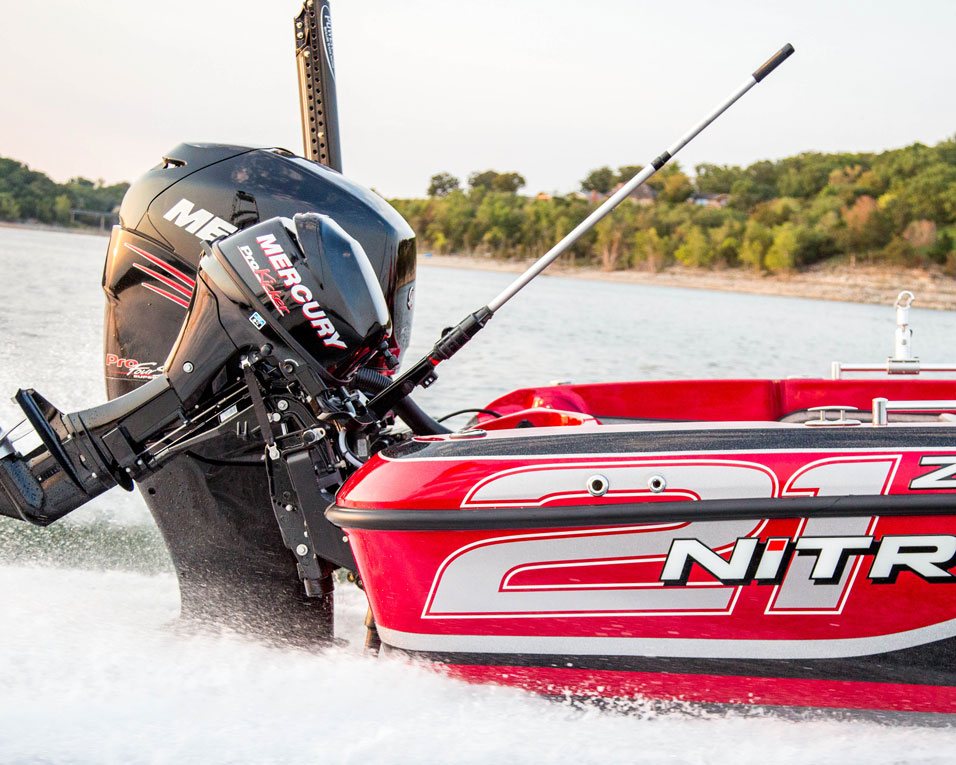 The performance aspects of the boat are no less impressive. Its Deep V design allows the boat to slice through the waves. Mason says it also features a hybrid of the Rapid Planing System transom, allowing for better holeshots.
The performance aspects of the boat are no less impressive. Its Deep V design allows the boat to slice through the waves. Mason says it also features a hybrid of the Rapid Planing System transom, allowing for better holeshots.
Plus, the boat is rated to handle up to a 350-horsepower motor.
Combine that with a 64-gallon gas tank, and the Northern anglers are looking at some serious long-range potential.
“The boat has a huge gas tank and high horsepower rating, allowing us to look further and go faster in almost every water condition,” Carroll says.
Another competitive advantage!
Plus, the hull is designed to track “beautifully,” making it a dream to control. And as all walleye anglers know, boat control is truly the key to a successful walleye fishing trip, where presentation is everything, Carroll says.
In the end, the efforts of the NITRO engineering team are rewarded by universal acclaim from all the top walleye anglers.
“The first thing that went through my head when I first set foot into it is that it’s the best Deep V boat made for the north—period,” Chase Parsons says. “And I still think that after being in it a full year.
“I fully believe that the ZV 21 is the best, strongest, most well-built boat that NITRO has ever made. It has the best fishing layout for the Northern-style boat up here—bar none…The hull is a phenomenal design. It runs rough water better than any boat in the market.”


